p.105
p.113
p.118
p.126
p.132
p.139
p.145
p.151
p.157
3D Phase-Field Simulation and Characterization of Microstructure Evolution during Liquid Phase Sintering
Abstract:
Liquid phase sintering (LPS) is widely used as a materials processing technique for hightemperature applications. In LPS, particle-particle contact size and distribution, 3-D coordination number, connectivity, and contiguity are important microstructure parameters which, to a large extent, determine the mechanical properties of the sintered materials. These features all depend on the grain size, solid volume fraction and dihedral angle during sintering. The dihedral angle is an important parameter in LPS. It is the angle formed between the 2 solid-liquid interfaces at the intersection of a grain boundary with the liquid. A higher solid volume fraction, on the other hand, favors a larger 3-D coordination number, connectivity, and contiguity. In practice, studying the correlation between these parameters and direct measurement of them is not a trivial task. Among them, 3-D measurement of dihedral angle is believed to be the most challenging one. In the current study, phase-field modeling is employed to simulate LPS in two phase systems (solid and liquid). Simulations are performed for the different ratios of grain boundary to solid-liquid energies and the different solid volume fractions. To create initial structures with high solid volume fraction, an advanced particle packing algorithm is employed. An extended sparse bounding-box algorithm is used to speed-up the computations and makes it computationally efficient for 3-D simulations. Contiguity, connectivity, and three dimensional coordination number were measured in the self similar regime. The results were compared with empirical rules and experimental data and are used to estimate the mean 3-D dihedral angle.
Info:
Periodical:
Pages:
132-138
Citation:
Online since:
October 2014
Authors:
Price:
Сopyright:
© 2014 Trans Tech Publications Ltd. All Rights Reserved
Share:
Citation:


